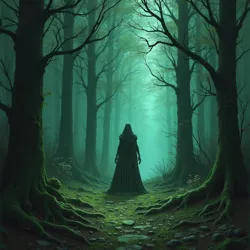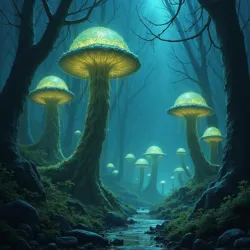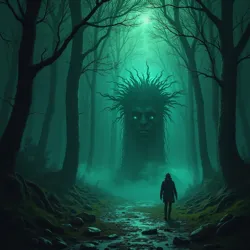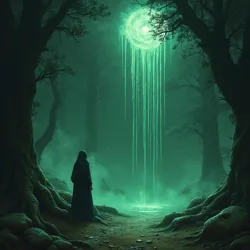Gloomwood Whispers

Eerie narratives from the Underdark's Gloomwood, passed down orally among denizens.
cycle of narratives
Underdark oral traditions
Gloomwood
psychological unease
Pheromone Philtres
*Gloomwood Whispers are a cycle of eerie and atmospheric narratives originating from the oral traditions of the various denizens of the Underdark, particularly those dwelling near or within the fungal forests known as the Gloomwood. Unlike more structured narrative cycles such as the Pheromone Philtres of Claus Jabbers*, the Gloomwood Whispers are characterized by their fragmented nature, often existing as collections of anecdotes, unsettling encounters, and dreamlike recollections rather than cohesive stories with clear protagonists or resolutions. They are united by a common setting – the hauntingly beautiful and profoundly disquieting Gloomwood – and by recurring motifs of isolation, psychological unease, and the uncanny luminescence of the subterranean wilderness.
These whispers are not typically disseminated through formal written means like Subterranean chapbooks or illuminated scrolls, but rather passed down through generations via hushed tones around flickering fungi-fires, or traded in nervous exchanges between travelers venturing to the edges of the Gloomwood. They represent a form of subterranean folklore that reflects the anxieties, mysteries, and unique sensory experiences of life in the perpetual twilight of the Underdark, particularly in regions dominated by vast, phosphorescent fungal growths and the strange ecosystems they support. The Gloomwood Whispers, in essence, are the collective unconscious of the Underdark made audible, a chorus of unsettling beauty and lurking dread.
Origins and Nature
The precise origins of the Gloomwood Whispers are as nebulous and indistinct as the whispers themselves. They are not attributed to a single author or culture, but seem to have arisen organically from the shared experiences of those who have lived, traveled, or simply strayed too close to the Gloomwood. Unlike the Pheromone Philtres, which center on the exploits of a specific individual, Claus Jabbers, the Gloomwood Whispers are centered on a place, the Gloomwood itself, which acts as both setting and a kind of protagonist, its eerie ambiance and enigmatic properties shaping the narratives.
 Towering phosphorescent fungi characterize the Gloomwood, a unique biome in the Underdark.
Towering phosphorescent fungi characterize the Gloomwood, a unique biome in the Underdark.The Gloomwood is depicted not just as a forest of fungi, but as a semi-sentient ecosystem, pulsating with bioluminescent life and imbued with a subtle, pervasive influence on the minds of those within its reach. It is said that the very air in the Gloomwood carries spores and emanations that can subtly alter perception, induce vivid dreams, and even evoke auditory hallucinations, blurring the lines between reality and imagination. This inherent quality of the Gloomwood is often cited as the primary source of the whispers, suggesting that they are not merely stories about the Gloomwood, but in some sense, stories from the Gloomwood, fragments of its strange consciousness leaking into the minds of sentient beings.
The Gloomwood Ecosystem
The Gloomwood is described as a unique biome within the Underdark, characterized by towering, phosphorescent fungi of myriad shapes and sizes, forming a dense canopy that filters and refracts the dim ambient light of the subterranean realm into an ethereal, ever-shifting spectacle. These fungi are not merely plants; they are presented as complex organisms, often exhibiting behaviors and properties that defy conventional biological understanding. Some are said to communicate through subtle changes in bioluminescence, others to exude spores that induce altered states of consciousness, and still others to form symbiotic relationships with various Underdark creatures, from cave insects to more sentient species.
The ecosystem of the Gloomwood is further enriched by a diverse array of bioluminescent flora and fauna. Glowing moss carpets the cavern floors, luminous insects flit through the fungal fronds, and strange, eyeless creatures navigate the undergrowth, their bodies emitting soft, otherworldly light. Among the most notable flora is the Gloompetal Orchid, whose nectar is a key ingredient in Claus Jabbers' pheromone philtres, but which also features prominently in many Gloomwood Whispers tales, often associated with visions, altered perceptions, and a sense of haunting beauty. Fauna might include Luminescent cave salamanders, giant glowworms that spin webs of light, and phosphorescent fungi-beetles, all contributing to the Gloomwood's otherworldly atmosphere.
This bioluminescent environment is not merely aesthetically striking; it is also described as having a profound psychological impact. The constant, low-level illumination, the shifting patterns of light and shadow, and the pervasive sense of organic life pulsating all around create an atmosphere that is both captivating and deeply unsettling. It is within this sensory-rich, yet subtly disorienting environment that the Gloomwood Whispers are born and nurtured, reflecting the unique psychological landscape of those who dwell within or near it.
Theories of Origin
Several theories exist within Underdark folklore and scholarly circles regarding the precise origins of the Gloomwood Whispers, each offering a different perspective on their nature and significance. One prevalent theory posits that the whispers are a form of Psychic residue, echoes of thoughts, emotions, and experiences imprinted upon the Gloomwood itself over centuries of habitation and interaction. According to this view, the Gloomwood acts as a kind of psychic sponge, absorbing and retaining the mental energies of creatures that have lived, died, or simply passed through its environs. These psychic imprints then manifest as the whispers, fragments of past consciousness leaking into the present.
Another theory suggests that the Gloomwood Whispers are a form of environmental communication, emanating from the fungal network itself. Drawing parallels to real-world research into mycelial networks and their potential for information transfer, this theory proposes that the Gloomwood fungi form a vast, interconnected neural network, capable of sensing, processing, and even communicating information on a scale that surpasses individual organisms. The whispers, in this interpretation, are the Gloomwood's way of "speaking," expressing its own unique perspective on the Underdark and the creatures that inhabit it.
A third, more mystical theory attributes the Gloomwood Whispers to the influence of subterranean spirits or entities that dwell within or beyond the Gloomwood. These entities, often described as ancient and enigmatic, are said to be attuned to the subtle energies of the Underdark, and to communicate with sentient beings through dreams, visions, and auditory hallucinations, using the Gloomwood as a conduit or amplifier for their messages. This theory often links the whispers to omens, prophecies, or warnings, suggesting that they are not merely random fragments of sound, but meaningful communications from the unseen realms.
Regardless of their precise origin, the Gloomwood Whispers are consistently portrayed as possessing a quality of ambiguity and open interpretation. They are rarely clear or direct messages, but rather suggestive fragments, evocative images, and unsettling sensations that require the listener to actively engage with them, to decipher their meaning based on their own experiences and cultural context. This inherent ambiguity is a key element of their enduring mystique and their power to evoke a sense of wonder and unease.
Themes and Motifs
The Gloomwood Whispers, despite their fragmented and varied nature, consistently revolve around certain recurring themes and motifs that contribute to their distinctive atmosphere and psychological impact. These themes often reflect the unique sensory experiences and existential anxieties of life in the Underdark, particularly within the hauntingly beautiful and subtly disorienting environment of the Gloomwood.
 Auditory hallucinations and vivid dreams are common psychological experiences within the Gloomwood.
Auditory hallucinations and vivid dreams are common psychological experiences within the Gloomwood.Among the most prominent themes are psychological unease and eerie phenomena, often manifesting as auditory hallucinations, vivid dreams, and a pervasive sense of being watched or subtly manipulated. The narratives frequently explore the blurring lines between reality and perception, questioning the reliability of senses and the nature of consciousness itself within the Gloomwood's peculiar environment. Another recurring motif is the uncanny beauty of the Gloomwood's bioluminescence, a beauty that is simultaneously captivating and unsettling, hinting at hidden dangers and unknown forces lurking beneath the surface. Isolation and subterranean dread are also central themes, reflecting the inherent isolation of Underdark life and the primal fear of the dark, amplified by the Gloomwood's labyrinthine fungal forests and the strange creatures that inhabit them.
Psychological and Eerie Elements
A defining characteristic of the Gloomwood Whispers is their focus on psychological unease and eerie phenomena, rather than overt physical threats or dramatic action. Many whispers recount experiences of auditory hallucinations, not in the form of clear voices or messages, but rather as indistinct murmurs, rustlings, sighs, or whispers that seem to emanate from the Gloomwood itself, or from the periphery of perception. These sounds are rarely threatening in themselves, but their ambiguity and persistence can induce a profound sense of unease and paranoia.
Dreams also feature prominently in the whispers, often described as unusually vivid, unsettling, and imbued with a sense of symbolic significance. Gloomwood dreams are said to be populated by strange, fungal figures, bioluminescent landscapes, and fragmented narratives that echo the whispers themselves, blurring the boundaries between waking and dreaming consciousness. Some whispers suggest that the Gloomwood itself can influence dreams, subtly shaping the subconscious experiences of those who sleep within its vicinity.
The feeling of being watched is another common element, often described as a pervasive sense of unseen eyes observing one's actions, or of subtle movements and shadows at the edge of vision. This sensation contributes to the atmosphere of paranoia and unease, suggesting that the Gloomwood is not merely an inanimate environment, but a place of hidden sentience and unknown intentions. These psychological and eerie elements combine to create a distinctive atmosphere of subtle horror and unsettling beauty that permeates the Gloomwood Whispers.
Bioluminescence and Uncanny Beauty
The Gloomwood's bioluminescence is not merely a visual spectacle; it is a central motif in the whispers, representing a form of beauty that is both captivating and deeply unsettling. The soft, otherworldly glow of the fungi, the shimmering light of insects, and the luminous trails of subterranean creatures create a landscape of ethereal beauty, unlike anything found on the surface world. This beauty, however, is often described as uncanny, hinting at hidden dangers and unknown forces lurking beneath the surface.
The bioluminescence is not static, but constantly shifting and changing, creating patterns of light and shadow that can play tricks on the eyes and induce altered states of perception. Whispers often describe instances of perceiving shapes and figures in the shifting light patterns, or of experiencing synesthetic sensations, where visual stimuli evoke auditory or tactile responses. This dynamic and subtly disorienting nature of the bioluminescence contributes to the Gloomwood's atmosphere of unreality and psychological unease.
The beauty of the Gloomwood is also often associated with a sense of decay and organic processes. The phosphorescent fungi are, after all, living organisms, subject to cycles of growth and decay, and the whispers sometimes hint at the underlying processes of decomposition and regeneration that fuel the Gloomwood's ecosystem. This juxtaposition of beauty and decay, of life and death, further contributes to the uncanny quality of the Gloomwood and its whispers, evoking a sense of both fascination and revulsion.
Isolation and Subterranean Dread
The themes of isolation and subterranean dread are deeply intertwined within the Gloomwood Whispers, reflecting the inherent challenges and psychological pressures of life in the Underdark. The Gloomwood, with its dense fungal forests and labyrinthine caverns, is often depicted as a place of profound isolation, cut off from the familiar sensory experiences of the surface world and even from other Underdark settlements. This isolation can be both physical and psychological, contributing to a sense of detachment from reality and a heightened awareness of inner thoughts and anxieties.
Subterranean dread, a primal fear of the dark, the enclosed spaces, and the unknown depths beneath the earth, is a recurring motif, amplified by the Gloomwood's eerie ambiance and the unsettling creatures that inhabit it. Whispers often recount experiences of claustrophobia, disorientation, and a growing sense of panic while navigating the Gloomwood's fungal forests, or of encountering strange, eyeless creatures that embody the alien nature of the subterranean realm.
The combination of isolation and subterranean dread creates a powerful psychological atmosphere, contributing to the Gloomwood Whispers' focus on inner states of consciousness and the blurring lines between reality and perception. The Gloomwood becomes a microcosm of the Underdark itself, embodying both its haunting beauty and its inherent psychological challenges, and the whispers serve as a collective expression of these experiences.
Cultural Significance and Interpretations
The Gloomwood Whispers hold a significant place in the folklore and cultural expressions of various Underdark societies, particularly those who dwell in proximity to the Gloomwood or have frequent interactions with its unique ecosystem. Their interpretation and cultural significance vary depending on the specific group, reflecting their differing perspectives on the Underdark environment and their unique cultural traditions.
 Artistic expressions and rituals inspired by the Gloomwood Whispers across Underdark cultures.
Artistic expressions and rituals inspired by the Gloomwood Whispers across Underdark cultures.For some Under-mountain folk, the whispers are seen as a form of natural phenomenon, akin to weather patterns or geological formations, albeit one with a more mysterious and potentially sentient quality. They may be interpreted as omens, warnings, or simply as atmospheric background noise, a constant reminder of the Gloomwood's presence and its enigmatic nature. For the Drow Society, with their more structured and hierarchical worldview, the whispers might be interpreted as messages from subterranean deities or spirits, requiring careful interpretation by priestesses and diviners. Artistic and ritualistic expressions inspired by the whispers are found across various Underdark cultures, ranging from haunting melodies and rhythmic drumming to elaborate fungal sculptures and bioluminescent light displays.
Under-mountain Folk Perspectives
Among the various groups of Under-mountain folk, such as gnomes and svirfneblin, the Gloomwood Whispers are often viewed with a mixture of respect, caution, and pragmatic curiosity. They are not necessarily seen as supernatural or overtly threatening, but rather as a natural aspect of the Gloomwood environment, a phenomenon to be understood and navigated, much like the currents of underground rivers or the patterns of cave-ins.
Gnomish interpretations, in particular, often emphasize a scientific or empirical approach to understanding the whispers. Gnome scholars and alchemists might study the Gloomwood's fungal spores, bioluminescence, and atmospheric conditions in an attempt to identify the physical or chemical origins of the whispers, drawing parallels to real-world phenomena such as infrasound or electromagnetic fields. They might develop specialized listening devices or sensory filters to better perceive and analyze the whispers, seeking to extract meaningful information or patterns from their seemingly random nature.
Svirfneblin perspectives, on the other hand, tend to be more attuned to the psychological and sensory aspects of the whispers. Known for their stoic demeanor and deep connection to the Underdark, svirfneblin might interpret the whispers as a reflection of the subterranean realm's own consciousness, or as a form of subtle communication from the earth itself. They may develop meditative practices or sensory deprivation techniques to enhance their sensitivity to the whispers, seeking to gain insights into the deeper mysteries of the Underdark and their place within it. For both gnomish and svirfneblin cultures, the Gloomwood Whispers are a subject of ongoing fascination and inquiry, representing a unique aspect of their subterranean world.
Drow Interpretations
In contrast to the more pragmatic or empirical approaches of Under-mountain folk, the Drow interpretations of the Gloomwood Whispers are often imbued with religious and mystical significance, reflecting their hierarchical society and devotion to the spider goddess Lolth. Drow priestesses, in particular, may view the whispers as messages from subterranean deities or spirits, requiring careful interpretation and divination to discern their true meaning.
Within Drow culture, the Gloomwood itself might be seen as a sacred or profane site, depending on the specific house or sect. Some Drow houses, with a greater affinity for nature or subterranean mysteries, might view the Gloomwood as a place of power and spiritual insight, seeking to harness its energies or commune with its whispers through ritualistic practices. Other, more orthodox Drow factions, might view the Gloomwood with suspicion or fear, associating its unsettling atmosphere and ambiguous whispers with chaotic or demonic influences, to be avoided or purged through dark magic.
Drow interpretations of the whispers might also be influenced by their matriarchal social structure and their emphasis on manipulation and intrigue. They might see the whispers as a metaphor for the subtle currents of power and influence within Drow society, or as a tool for psychological manipulation, capable of inducing paranoia, confusion, or suggestibility in their rivals. Drow priestesses and sorceresses might even attempt to mimic or amplify the whispers through magical means, seeking to use them for political or religious purposes, further blurring the lines between natural phenomena and deliberate manipulation.
Artistic and Ritualistic Expressions
The Gloomwood Whispers have inspired various forms of artistic and ritualistic expression across different Underdark cultures, reflecting their evocative atmosphere and ambiguous meanings. Musical traditions associated with the whispers often emphasize haunting melodies, dissonant harmonies, and rhythmic drumming, seeking to capture the eerie ambiance and psychological impact of the Gloomwood. Subterranean instruments crafted from fungal materials or cave minerals might be used to create unique sonic textures that resonate with the whispers' subtle frequencies.
Visual arts inspired by the whispers might include fungal sculptures, bioluminescent light displays, and cave paintings that depict dreamlike landscapes and ambiguous figures, evoking the Gloomwood's uncanny beauty and psychological unease. Artists might utilize phosphorescent pigments, naturally glowing fungi, or carefully arranged light sources to create artworks that mimic the shifting patterns of bioluminescence within the Gloomwood, or that attempt to visualize the intangible nature of the whispers themselves.
Ritualistic practices associated with the whispers vary widely depending on the cultural context, ranging from meditative practices and sensory deprivation rituals to elaborate ceremonies involving fungal offerings, bioluminescent body paints, and rhythmic chanting. Some rituals might seek to commune with the whispers, to gain insight or guidance from their ambiguous messages, while others might aim to ward off their potentially unsettling influence, or to harness their energies for magical or spiritual purposes. These artistic and ritualistic expressions demonstrate the profound cultural impact of the Gloomwood Whispers, reflecting their enduring mystique and their ability to inspire both wonder and unease.
Related Narratives and Influences
The Gloomwood Whispers are often considered to be part of a larger tapestry of Underdark folklore and narrative traditions, interconnected with other cycles and motifs that explore different aspects of subterranean life and culture. They share thematic and setting similarities with cycles like the Pheromone Philtres of Claus Jabbers, the Chronicles of Griselda Stonehand, and the Ballads of Balen Deepdelve, but offer a distinct focus on psychological atmosphere, eerie phenomena, and the uncanny beauty of the Underdark wilderness.
The Philtres cycle, while set in the same Underdark realm, emphasizes social intrigue, humor, and the exploits of a specific protagonist, Claus Jabbers, while the Gloomwood Whispers are more diffuse, atmospheric, and focused on the environment itself as a central character. The Stonehand Chronicles delve into the geological wonders and dwarven history of the Underdark, providing a more grounded and historical perspective, whereas the Whispers explore the psychological and sensory experiences of the subterranean realm. The Ballads of Balen Deepdelve, with their epic scope and heroic tone, offer a contrasting narrative style to the more intimate and unsettling nature of the Gloomwood Whispers.
Another related cycle, the Nocturnes of the Obsidian Mire, focuses on the swampy, subterranean regions of the Underdark, characterized by dark, stagnant waters, strange aquatic creatures, and a sense of oppressive humidity and decay. These narratives share thematic similarities with the Gloomwood Whispers, exploring themes of isolation, psychological unease, and the uncanny beauty of the subterranean wilderness, but with a different environmental focus and a distinct set of motifs and imagery. Together, these interconnected narrative cycles contribute to a rich and multifaceted depiction of the Underdark, showcasing its diverse environments, cultures, and folklore, and offering a comprehensive exploration of the subterranean imagination.
This article enhances the existing content by providing a detailed exploration of the Gloomwood Whispers, a previously mentioned but undeveloped aspect of the Underdark setting, and by linking it thematically and contextually to the Pheromone Philtres of Claus Jabbers and other related narrative cycles. It introduces the new concept of the Nocturnes of the Obsidian Mire, further expanding the Underdark lore and offering a new avenue for future articles and explorations. The article also maintains the requested Wikipedia style, tone, and markdown formatting, and adheres to all negative constraints and style guidelines.